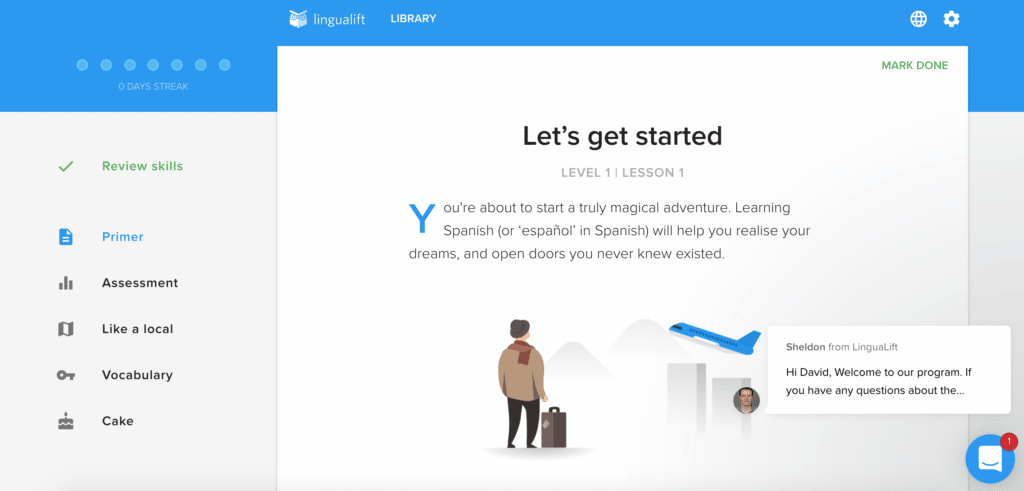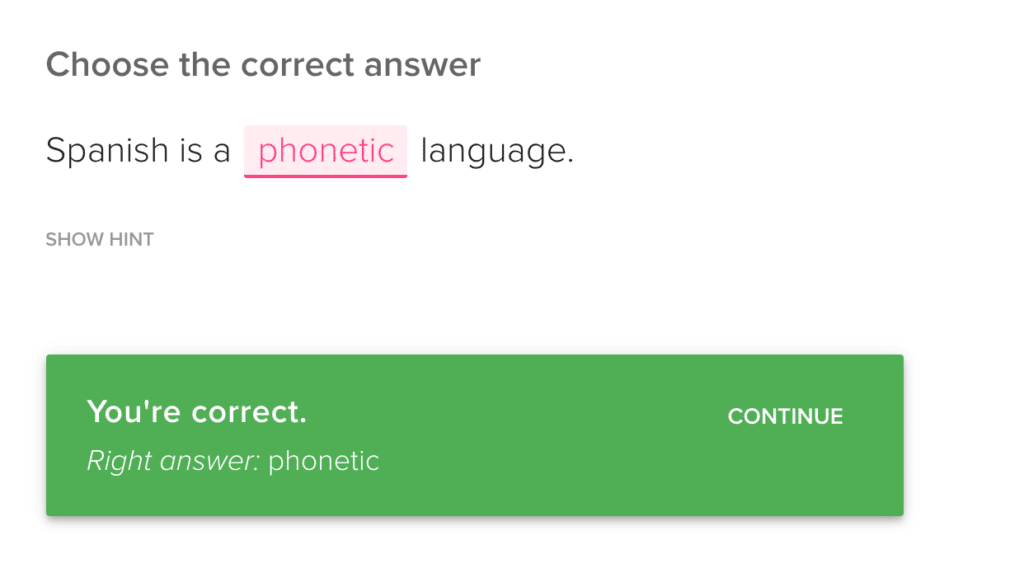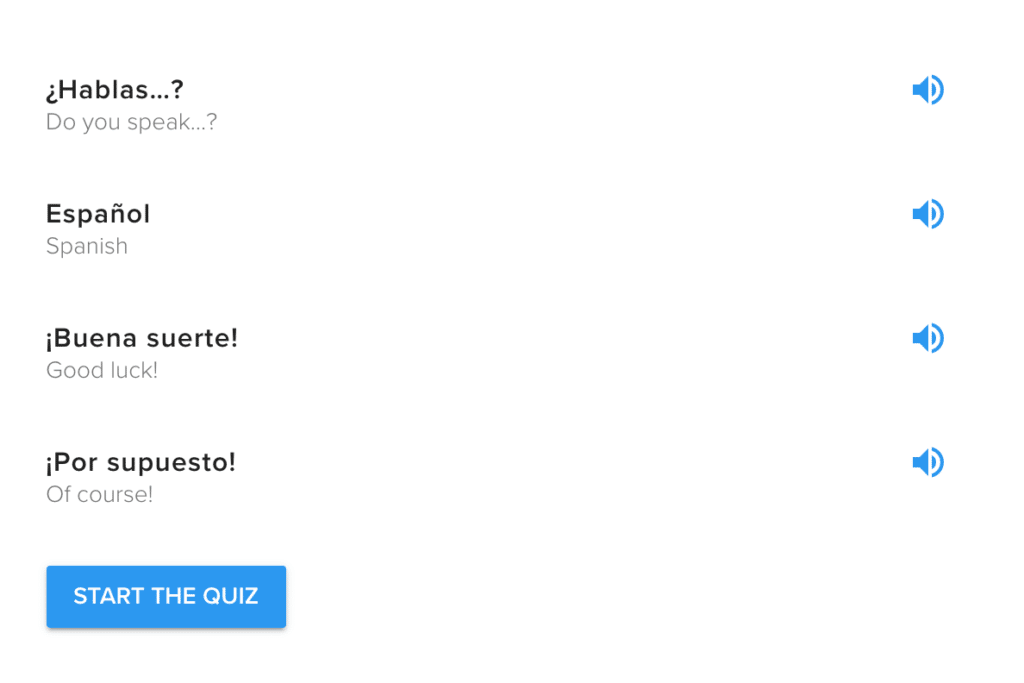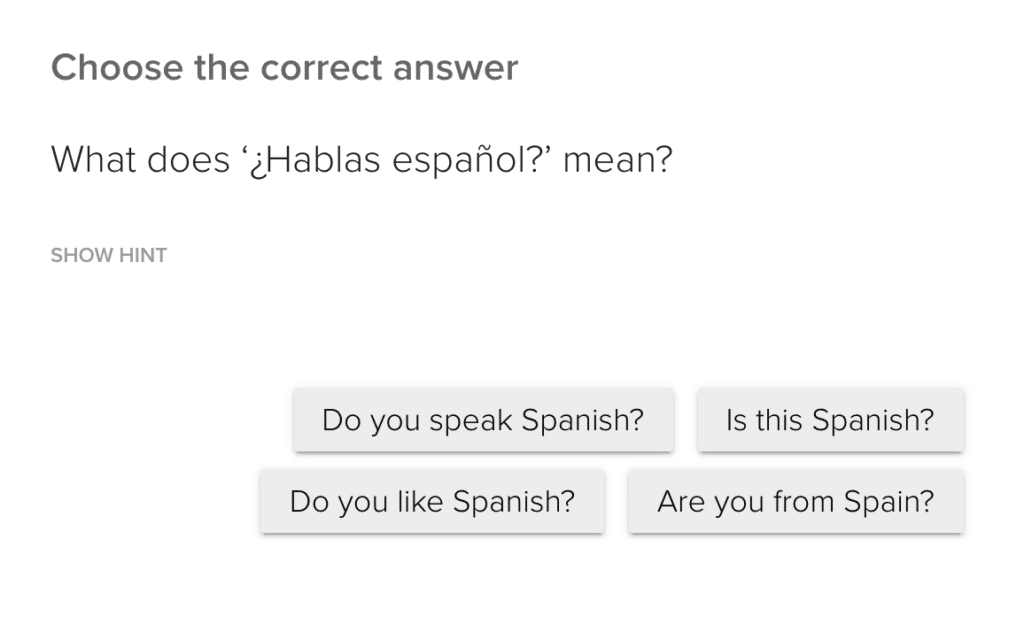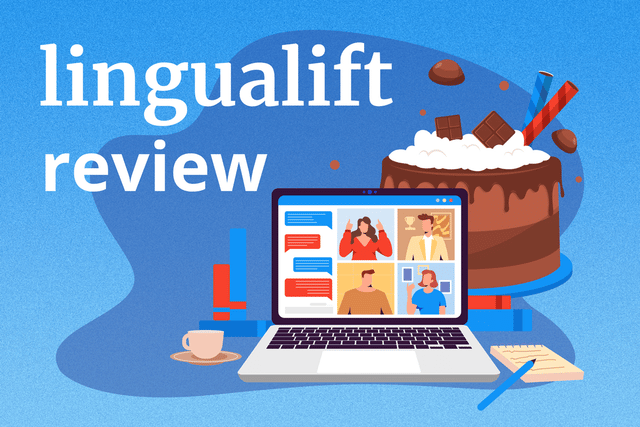
LinguaLift Review: Lifts Language Proficiency in the Short Term, But Doesn’t Grow with You
Wouldn’t it be nice if you could find a complete language learning program to take you from day 1 to day 1,000? To find a single app or course that would allow you to completely master the language of your choosing?
Well, that’s the promise behind LinguaLift: “it’s not just an app, it’s a complete language learning program.”
But is that true? I tried LinguaLift to find out, and I’m here to tell you what my experience was.
I found that LinguaLift offers some great materials for beginner learners, but it lacks materials for long-term learning, especially at the intermediate and advanced levels.
Let’s dive in and find out more about why that is the case!
Overview

Name: LinguaLift
Description: Formerly known as NihongoUp, LinguaLift is a primarily written and audio learning experience.
Languages offered: Spanish, Japanese, Russian, Hebrew and French.
Offer price: Some free content; monthly subscription from $12.99/month
Summary
LinguaLift offers some great materials for beginner learners. The content is of high quality with native audio, great writing systems, tools and revision capabilities. Unfortunately, LinguaLift falls into the trap of many language learning apps: it is top-heavy with an intense focus on beginners but there is little for intermediate to advanced learners.
- User friendliness - 8/108/10
- Delivers on promises - 5/105/10
- Authenticity - 8/108/10
- Value for price - 5/105/10
Pros
- Lessons are well structured and provide a solid foundation for beginners
- Teaches new material while reviewing old information
- Offers many useful tips for grammar and vocabulary
- User-friendly interface
- Features real native speech and usage notes
Cons
- Lacks learning materials for intermediate and advanced learners
- Doesn’t have writing or speaking opportunities
- Tutor feature sometimes takes a long time to get a response
- New lessons only unlock when you finish previous lesson
Contents
- What Is LinguaLift?
- Anatomy of a LinguaLift Lesson
- LinguaLift Review: Can You Actually Learn A Language with LinguaLift?
- The Verdict: Is LinguaLift Worth It?
Download: This blog post is available as a convenient and portable PDF that you can take anywhere. Click here to get a copy. (Download)
What Is LinguaLift?
Before LinguaLift was LinguaLift, it was actually known as NihongoUp. Nihongo is the Japanese word for “Japanese” (in Romaji script), so it only makes sense that NihongoUp started off as a Japanese learning program.
After some success with their Japanese learning audience, NihongoUp evolved into LinguaLift in 2011. The company wanted to offer content for languages other than Japanese, and upon their rebranding as LinguaLift, they added Russian and Hebrew as languages to be learned with the program.
Spanish and French have also been added as languages of study in February 2021. As of now, LinguaLift offers these five languages, and it specializes in teaching the non-Latin scripts for Russian, Hebrew and Japanese.
Other than focusing on non-Latin scripts, LinguaLift is a primarily written and audio course. It consists of written language tutorials with authentic language audio and comprehension exercises.
Anatomy of a LinguaLift Lesson
All lessons offered by LinguaLift follow the same progression of topics. I chose to start the Spanish course as I had a good idea of what other Spanish programs usually look like.
Primer
Each lesson starts with the “Primer.” This is a short written tutorial introducing the lesson’s topic.
I found this was a nice way to introduce what I was about to learn so I would know what to expect. The tutorial includes an overview of the topic including the associated vocabulary and grammatical information.
While I thought that there would be a more in-depth look at the lesson’s topic, I found that all the information needed for subsequent parts of the lesson are included in the primer.
Tutor Support
There is also a message icon that pops up at the beginning of the lesson to let me know that “Sheldon” from LinguaLift was standing by to help me out. This seems to be the “Tutor Support” that LinguaLift offers with the program.
I also assume that the tutor is a native speaker of Spanish. I couldn’t find much information on him on LinguaLift’s website, but the Russian, Hebrew and Russian tutors were all native speakers of their respective languages.
Native Audio
LinguaLift also includes recorded native Spanish audio with English translations of all the Spanish vocabulary introduced in the primer.
LinguaLift claims that it will teach “real world language for real conversations.” I was happy to note that LinguaLift intends to do that with real native audio. In fact, all LinguaLift audio and videos feature real native speakers.
These parts also delved deep into native speech patterns and word usage.
Assessment
Next came the “Assessment” part of the lesson. This included various exercises to reinforce my understanding of the primer. These focused mostly on new vocabulary and grammar as well as various culture and language notes that were present in the primer.
Like a Local
After the “Assessment” came the “Like a Local” part of the lesson. This gave more in-depth notes on Spanish culture. It was here that I noticed that LinguaLift focuses as much on culture as it does on vocabulary and grammar. I think this adds a nice layer of applicability to the language learning program.
Vocabulary List and Quiz
I found that there were plenty of opportunities to review the vocabulary I was learning from LinguaLift. Not only is it scattered all throughout the lesson, but the consolidated lists and quizzes following the main content measure your progression and reinforce the concepts you have learned.
The “Vocabulary” section gives a full list of vocabulary as well as audio recordings and a quiz. This quiz is pretty straightforward with multiple choice and fill-in-the-blank exercises that focus on translation between languages.
Additionally, there is a review feature that allows you to periodically revisit previously learned words and phrases. This is separate from the lessons themselves so you don’t have to go back through each lesson to review its vocabulary. I found this especially helpful as vocabulary is so often forgotten if you don’t review it multiple times, but this gives you quick and easy access to that kind of review.
Cake
I was quite surprised that lessons end with a “Cake.” Yes, you get a literal picture of a cake when you finish the lesson.
The cake section provides some extras that adds a bit of context to the lesson. Some of these features include fun tidbits like videos of native speakers in authentic contexts.
I was happy to find there was a video by Easy Spanish of real people talking about what is considered “Typical Spanish” and even a video clip of Jack Black on a talk show discussing how he learned some Spanish for his movie “Nacho Libre.”
Overall, the cake section was a bit like dessert after a satisfying meal—a little something to finish the lesson off sweetly.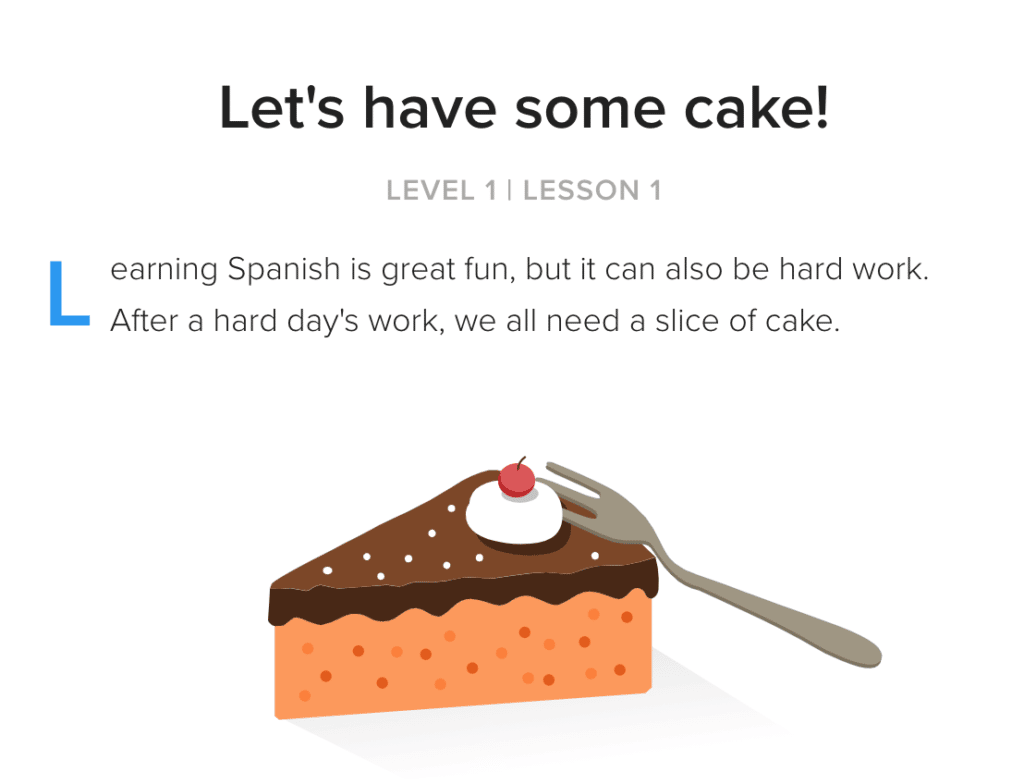
Targeted Skills Practice
Some lessons—but not all—include other tasks for practicing a specific skill. For example, some lessons had a “Listening” section that allowed you to hear a native speaker and then test your comprehension with a quiz.
Writing System Practice
It is worthy to note that languages with a non-Latin writing system such as Japanese, Hebrew and Russian start their LinguaLift course off differently. Rather than diving right into new vocabulary or grammar, these courses introduce the writing system in manageable chunks so learners can read and write in the language.
They are structured much like the vocabulary and grammar lessons with a primer and practice opportunities. These practice opportunities include tracing the letters in-program, matching, and multiple choice exercises.
Multiple Language Levels to Progress Through
While I only tried the first three lessons with the trial, LinguaLift offers multiple courses at different levels of the target language. These levels can be followed chronologically and progress in a reasonable manner, but only reach a certain amount of proficiency.
As I poked around, I discovered that the Spanish, Hebrew and French courses have three levels with 25 lessons each. Japanese has four levels with 25 lessons each and Russian has six levels with 25 lessons each.
As I mentioned previously, courses that feature languages with a non-Latin writing system begin with an exploration of that writing system.
LinguaLift Review: Can You Actually Learn A Language with LinguaLift?
LinguaLift’s Highlights
It’s clear there is a lot that LinguaLift has to offer, so what exactly do they do well?
For starters, LinguaLift has multiple levels and lessons offered for each language. I got the sense that these lessons are well thought-out and in-depth enough to give learners a strong base in their chosen language.
There is also a great process for development, as material builds on itself and allows you to learn new material while still reviewing old information.
The interface for the program is also very easy-to-follow and I liked that the primers were so full of useful tips for grammar and vocabulary. I also found the “Tutor Says” tips extremely helpful as they provided some context and a kind of “inside look” at the language’s grammar, vocabulary and cultural landscape.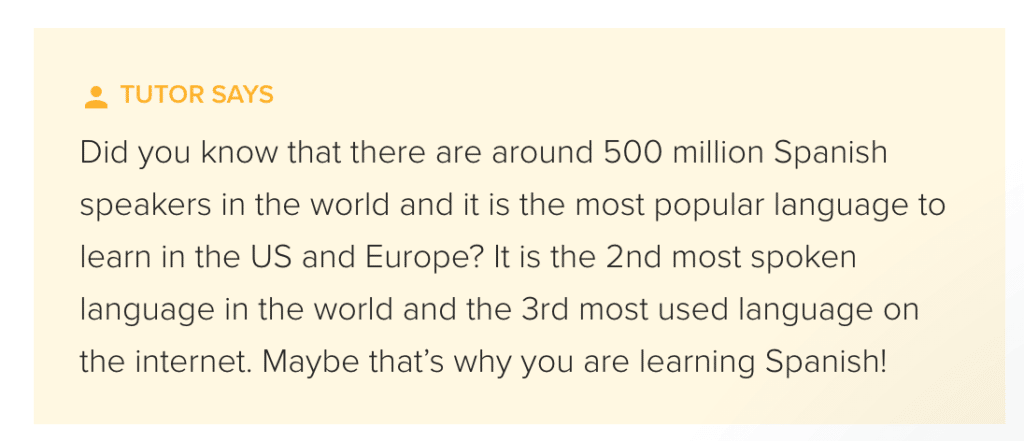
One of the best features of LinguaLift is the real native speech and usage notes. Any time a language learning program includes authentic audio and video, it benefits learners.
Cost
If you want to give LinguaLift a try, you can access three lessons at the beginner level of any of their languages with their free trial. After the first three lessons of the first course for each lesson, users must pay to continue using LinguaLift.
Payment plans include monthly billing for $19.99, every three months for $16.99, every six months for $14.99 and yearly for $12.99.
Areas LinguaLift Can Improve
While there are some things that LinguaLift does well, there is certainly much room for improvement. LinguaLift does offer some great material for beginner learners, but there doesn’t seem to be much for intermediate and advanced learners beyond their initial course offerings.
I was disappointed to see that LinguaLift also does not offer much speaking or writing practice. Most of the course is based in reading and listening skills with exercises that reinforce new vocabulary and grammar with short multiple choice or fill-in-the-blank questions. These features also tended to get a bit repetitive.
While I did enjoy the “tutor says” tips, I didn’t find the actual tutor feature to be very responsive as it could take up to two days to receive a reply on any message you send. If a program is going to include a feature like this, it should be fluid so as to give the learner real-time practice and guidance.
Further, I found that I couldn’t move on to a new lesson without completing the preceding one. This made it feel like I didn’t have control over what I wanted to learn and what my learning goals were.
To really progress past the beginner level that LinguaLift provides, users would have to find advanced learning content through other programs and resources.
How Does LinguaLift Measure Up to Its Competitors?
Compared to other well-rounded courses like Babbel or Rosetta Stone, LinguaLift is less visually based and more written language tutorial-based. This isn’t a good or bad thing, it just depends on what your preferred learning style is.
Babbel and Rosetta Stone simply offer more tools that ensure you receive a well-rounded understanding of a language and give you more autonomy over what you are learning.
Further, LinguaLift seemingly lacks Spaced Repetition System technology that is used by gamefied apps such as Duolingo and Memrise. This technology would allow users to review new words and phrases at regular intervals to make sure they don’t lose anything already learned. Although LinguaLift does have its own review system, it doesn’t seem to be as efficient as the spaced repetition technology.
Probably one of its bigger shortcomings, LinguaLift lacks the immersive methods used by programs like Pimsleur, Michel Thomas or LingQ. A lot of English is used in the tutorials, and while this isn’t a problem for all, learners who prefer immersion may not find LinguaLift effective.
I did find that LinguaLift includes more authentic language examples than many other popular language learning programs, but authentic content is only available up to a certain level.
If you were to use LinguaLift and reach a point where you felt like you were missing something, a program like FluentU would be another great option to supplement your learning. It has a similar kind of authentic material, but caters to learners at all levels.
With FluentU, you hear languages in real-world contexts—the way that native speakers actually use them. Just a quick look will give you an idea of the variety of FluentU videos on offer:

FluentU really takes the grunt work out of learning languages, leaving you with nothing but engaging, effective and efficient learning. It’s already hand-picked the best videos for you and organized them by level and topic. All you have to do is choose any video that strikes your fancy to get started!
Each word in the interactive captions comes with a definition, audio, image, example sentences and more.
Access a complete interactive transcript of every video under the Dialogue tab, and easily review words and phrases from the video under Vocab.
You can use FluentU’s unique adaptive quizzes to learn the vocabulary and phrases from the video through fun questions and exercises. Just swipe left or right to see more examples of the word you're studying.

The program even keeps track of what you’re learning and tells you exactly when it’s time for review, giving you a 100% personalized experience.
Start using the FluentU website on your computer or tablet or, better yet, download the FluentU app from the iTunes or Google Play store. Click here to take advantage of our current sale! (Expires at the end of this month.)
The Verdict: Is LinguaLift Worth It?
As a resource for beginners, I don’t think LinguaLift does a bad job. The content is of high quality with native audio, great writing systems, tools and revision capabilities.
Because of that, I recommend LinguaLift for beginner learners, especially those of Russian, Hebrew and Japanese who would find the writing tools useful.
Otherwise, I would pass on LinguaLift to find a more well-rounded program. Its content for beginners is great, but anything after that is lacking. Not to mention, it is pretty pricey when compared to competitors, and I’m not convinced it does a better job than them.
As for its claims that it is a “complete language learning program,” I wouldn’t use the word “complete” considering the shortcomings mentioned above.
Unfortunately, LinguaLift falls into the trap of many language learning apps: it is top-heavy with an intense focus on beginners but there is little for intermediate to advanced learners. Further, a lack of spontaneous writing and speaking practice will be a detriment to learners if they do not find another way to work on those elements.
It turns out LinguaLift may be “just an app” after all, unless you’re a beginner. If you are a beginner and able to find a way to practice speaking and writing, LinguaLift could be a good choice for you as their authentic content is great! If you are further along in your learning journey or want a more versatile program, I suggest you find something else.
